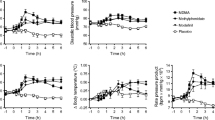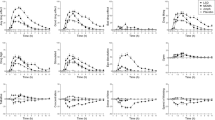Abstract
The performance of 43 long-term users (average = 5 years) of benzodiazepine (BZ) medications was examined on a battery of behavioral tasks, cognitive tests, and subjective mood rating scales. The performance of the chronic BZ users did not differ significantly from age- and sex-matched anxious subjects, except that critical flicker fusion (CFF) thresholds were lower and subjective ratings of tranquilization were higher in the BZ users. Twenty-two subjects were reexamined in order to determine the acute effects of BZ medications in long-term users. The acute administration of BZ medications significantly increased CFF thresholds, improved digit-symbol substitution test performance, impaired the delayed recall of verbal material, increased subjective ratings of tranquilization, and reduced physical sedation. Motor performance tests were not impaired and subjective feelings of sedation were not increased after the acute administration of BZs by chronic users. During withdrawal from long-term BZ use (17 subjects), CFF thresholds were elevated, subjective ratings of physical sedation and anxiety were increased, but performance on other psychomotor and cognitive tests was not altered. The results suggest that tolerance develops selectively to different behavioral and subjective effects of BZ medications with their continued use. Tolerance failed to develop to the antianxiety effects, the reduction of CFF threshold, and to the impairment of short-term memory caused by BZs. However, chronic users of BZ medications failed to demonstrate psychomotor-impairing or sedating effects to BZ medications. The results have implications for evaluating the safety of the long-term use of BZ medications.
Similar content being viewed by others
References
Angus WR, Romney DM (1984) The effect of diazepam on patient's memory. J Clin Psychopharmacol 4:203–206
Aranko K, Mattila MJ, Seppala T (1983) Development of tolerance and cross-tolerance to the psychomotor actions of lorazepam and diazepam in man. Br J Clin Pharmacol 15:545–552
Bergman H, Borg S, Holm L (1980) Neuropsychological impairment and exclusive abuse of sedatives or hypnotics. Am J Psychiatry 137:215–217
Cohen S (1981) A clinical appraisal of diazepam. Psychosomatics 22:761–769
de Gier JJ, Hart BJ, Nelemans FA, Bergman H (1981) Psychomotor performance and real driving performance of outpatients receiving diazepam. Psychopharmacology 73:340–344
File SE, Bond AJ (1979) Impaired performance and sedation after a single dose of lorazepam. Psychopharmacology 66:309–313
Frazure-Smith N, Rolicz-Woloszyk E (1982) Memory problems after ischemic heart disease episodes: Effects of stress, benzodiazepines and smoking. J Psychosom Res 26:613–622
Ghoneim MM, Mewaldt SP (1975) Effects of diazepam and scopolamine on storage, retrieval and organizational processes in memory. Psychopharmacologia 44:257–262
Ghoneim MM, Mewaldt SP, Berie JL, Hinrichs JV (1981) Memory and performance effects of single and 3-week administration of diazepam. Psychopharmacology 73:147–151
Ghoneim MM, Hinrichs JV, Mewaldt SP (1984a) Dose-response analysis of the behavioral effects of diazepam: I. Learning and memory. Psychopharmacology 82:291–295
Ghoneim MM, Hinrichs JV, Noyes R, Anderson DJ (1984b) Behavioral effects of diazepam and propranolol in patients with panic disorder and agoraphobia. Neuropsychobiology 11:229–235
Hartley LR, Spencer J, Williamson J (1982) Anxiety, diazepam and retrieval from semantic memory. Psychopharmacology 76:291–293
Hendler N, Cimini C, Terrence MA, Long D (1980) A comparison of cognitive impairment due to benzodiazepines and to narcotics. Am J Psychiatry 137:828–830
Hinrichs JV, Ghoneim MM, Mewaldt SP (1984) Diazepam and memory: retrograde facilitation produced by interference reduction. Psychopharmacology 84:158–162
Kleinknecht RA, Donaldson D (1975) A review of the effects of diazepam on cognitive and psychomotor performance. J Nerv Ment Dis 161:399–411
Kothary SP, Brown ACD, Pandit UA, Samara SK, Pandit SK (1981) Time course of antirecall effect of diazepam and lorazepam following oral administration. Anesthesiology 55:641–644
Liljequist R, Palva E, Linnoila M (1979) Effects of learning and memory of 2-week treatments with chlordiazepoxide lactam, N-desmethyldiazepam, oxazepam and methyloxazepam, alone or in combination with alcohol. Int Pharmacopsychiatry 14:190–198
Linnoila M, Erwin CW, Brendle A, Simpson D (1983) Psychomotor effects of diazepam in anxious patients and healthy volunteers. J Clin Psychopharmacol 3:88–96
Lippa AS, meyerson LR, Beer B (1982) Molecular substrates of anxiety: Clues from the heterogeneity of the benzodiazepine receptor. Life Sci 31:1409–1417
Lister RG (1985) The amnesic action of benzodiazepines in man. Neurosci Biobehav Rev 9:87–94
Lucki I, Rickels K, Geller AM (1985) Psychomotor performance following the long-term use of benzodiazepines. Psychopharmacol Bull 21:93–96
Mellinger GD, Balter MB (1981) Prevalence and patterns of use of psychotherapeutic drugs: Results from a 1979 national survey of American adults. In: Tognoni G, Bellantuono C, Lader M (eds) Epidemiological impact of psychotropic drugs, New York: Elsevier-North Holland, Inc, pp 117–135
Norris H (1971) The action of sedatives on brain stem oculomotor systems in man. Neuropharmacology 10:181–191
Paivio A, Yuille JC, Madigan SA (1968) Concreteness, imagery and meaningfulness values for 925 nouns. J Exp Psychol [Suppl] 76:1–25
Petursson H, Gudjonsson GH, Lader MH (1983) Psychometric performance during withdrawal from long-term benzodiazepine treatment. Psychopharmacology 81:345–349
Rickels K (1978) Use of antianxiety agents in anxious outpatients. Psychopharmacology 58:1–17
Rickels K (1981) Benzodiazepines: Use and misuse. In: Klein DF and Rabkin J (eds) Anxiety: New research and changing concepts, New York: Raven Press, pp 1–26
Rickels K, Case GW, Downing RW, Winokur A (1983) Long-term diazepam therapy and clinical outcome. JAMA 250:767–771
Salzman C, Shader RI, Harmantz J, Robertson L (1975) Psychopharmacologic investigations in elderly volunteers: Effect of diazepam in males. J Am Geriatr Soc 23:451–457
Schopf J (1983) Withdrawal phenomena after long-term administration of benzodiazepines: A review of recent investigations. Pharmacopsychiatria 16:1–8
Smith JM, Misiak H (1976) Critical flicker frequency (CFF) and psychotropic drugs in normal subjects — a review. Psychopharmacology 47:175–182
Thorndike EL, Lorge L (1944) The teachers word book of 30,000 words, New York: Columbia University Press
Vogel JR (1979) Objective measurement of human performance changes produced by antianxiety drugs. In: Fielding S, Lal H (eds) Anxiolytics, New York: Futura Publishing Co pp 343–374
Wechlser D (1955) Manual for the Wechsler Adult Intelligence Scale. New York: The Psychological Corp
Winokur A, Rickels K (1981) Withdrawal and pseudowithdrawal from diazepam therapy. J Clin Psychiatry 42:442–444
Winokur A, Rickels K, Greenblatt DJ, Snyder P, Schatz NJ (1980) Withdrawal reaction from long-term, low-dosage administration of diazepam. Arch Gen Psychiatry 37:101–105
Wittenborn JR (1970) Effects of benzodiazepines on psychomotor performance. Br J Clin Pharmacol 7:61S-67S
Zimmerman-Tansella C, Tansella M, Lader M (1978) Psychological performance in anxious patients treated with diazepam. Prog Neuro-Psychopharmacol 3:361–368
Author information
Authors and Affiliations
Rights and permissions
About this article
Cite this article
Lucki, I., Rickels, K. & Geller, A.M. Chronic use of benzodiazepines and psychomotor and cognitive test performance. Psychopharmacology 88, 426–433 (1986). https://doi.org/10.1007/BF00178503
Received:
Issue Date:
DOI: https://doi.org/10.1007/BF00178503




